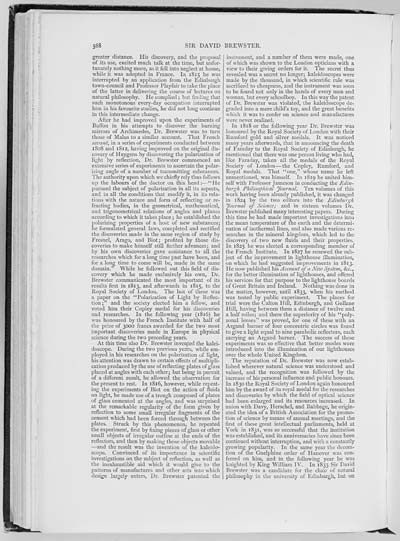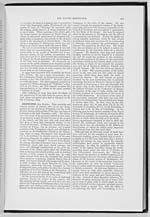Volume 3 > Half-Volume 6
(214) Page 568
Download files
Individual page:
Thumbnail gallery: Grid view | List view

568 greater distance. His discovery, and the proposal of its use, excited much talk at the time, but unfor- tunately nothing more, as it fell into neglect at home, while it was adopted in France. In 1815 he was interrupted by an application from the Edinburgh town-council and Professor Playfair to take the place of the latter in delivering the course of lectures on natural philosophy. He complied; but finding that such monotonous every-day occupation interrupted him in his favourite studies, he did not long continue in this intermediate change. After he had improved upon the experiments of Buffon in his attempts to discover the burning mirrors of Archimedes, Dr. Brewster was to turn those of Malus to a similar account. That French savant, in a series of experiments conducted between 1808 and 1812, having improved on the original dis- covery of Huygens by discovering the polarization of light by reflection, Dr. Brewster commenced an extensive series of experiments to ascertain the polar- izing angle of a number of transmitting substances. The authority upon which we chiefly rely thus follows up the labours of the doctor on this head:�"He pursued the subject of polarization in all its aspects, and in all the conditions that modify it, in its rela- tions with the nature and form of reflecting or re- fracting bodies, in the geometrical, mathematical, and trigonometrical relations of angles and planes according to which it takes place; he established the polarizing properties of a host of new substances; he formulated general laws, completed and rectified the discoveries made in the same region of study by Fresnel, Arago, and Biot; profited by those dis- coveries to make himself still further advances; and by his own discoveries gave assistance to all the researches which for a long time past have been, and for a long time to come will be, made in the same domain." While he followed out this field of dis- covery which he made exclusively his own, Dr. Brewster communicated the most important of its results first in 1813, and afterwards in 1815, to the Royal Society of London. The last of these was a paper on the "Polarization of Light by Reflec- tion;" and the society elected him a fellow, and voted him their Copley medal for his discoveries and researches. In the following year (1816) he was honoured by the French Institute with half of the prize of 3000 francs awarded for the two most important discoveries made in Europe in physical science during the two preceding years. At this time also Dr. Brewster invented the kalei- doscope. During the two previous years, while em- ployed in his researches on the polarization of light, his attention was drawn to certain effects of multipli- cation produced by the use of reflecting plates of glass placed at angles with each other; but being in pursuit of a different result, he allowed the observation for the present to rest. In 1816, however, while repeat- ing the experiments of Biot on the action of fluids on light, he made use of a trough composed of plates of glass cemented at the angles, and was surprised at the remarkable regularity of the form given by reflection to some small irregular fragments of the cement which had been forced through between the plates. Struck by this phenomenon, he repeated the experiment, first by fixing pieces of glass or other small objects of irregular outline at the ends of the reflectors, and then by making those objects movable �and the result was the invention of the kaleido- scope. Convinced of its importance in scientific investigations on the subject of reflection, as well as the inexhaustible aid which it would give to the patterns of manufactures and other arts into which design largely enters, Dr. Brewster patented the instrument, and a number of them were made, one of which was shown to the London opticians with a view to their giving orders for it. The secret thus revealed was a secret no longer; kaleidoscopes were made by the thousand, in which scientific rule was sacrificed to cheapness, and the instrument was soon to be found not only in the hands of every man and woman, but every schoolboy. In this way the patent of Dr. Brewster was violated, the kaleidoscope de- graded into a mere child's toy, and the great benefits which it was to confer on science and manufactures were never realized. In 1818 or the following year Dr. Brewster was honoured by the Royal Society of London with their Rumford gold and silver medals. It was noticed many years afterwards, that in announcing the death of Faraday to the Royal Society of Edinburgh, he mentioned that there was one person living who had, like Faraday, taken all the medals of the Royal Society of London�the Copley, Rumford, and Royal medals. That "one," whose name he left unmentioned, was himself. In 1819 he united him- self with Professor Jameson in conducting the Edin- burgh Philosophical Journal. Ten volumes of this work having been already published, it was changed in 1824 by the two editors into the Edinburgh Journal of Science; and in sixteen volumes Dr. Brewster published many interesting papers. During this time he had made important investigations into the mean temperature of the earth and the determi- nation of isothermal lines, and also made various re- searches in the mineral kingdom, which led to the discovery of two new fluids and their properties. In 1825 he was elected a corresponding member of the French Institute. In 1827 he renewed the sub- ject of the improvement in lighthouse illumination, on which he had suggested improvements in 1813. He now published his Account of a New System, &c., for the better illumination of lighthouses, and offered his services for that purpose to the lighthouse boards of Great Britain and Ireland. Nothing was done in the matter, however, until 1833, when his method was tested by public experiment. The places for trial were the Calton Hill, Edinburgh, and Gullane Hill, having between them a distance of twelve and a half miles; and there the superiority of his "poly- zonal lenses" was proved, for one of these with an Argand burner of four concentric circles was found to give a light equal to nine parabolic reflectors, each carrying an Argand burner. The success of these experiments was so effective that better modes were introduced into the illumination of our lighthouses over the whole United Kingdom. The reputation of Dr. Brewster was now estab- lished wherever natural science was understood and valued, and the recognition was followed by the increase of his personal influence and public honours. In 1830 the Royal Society of London again honoured him by the award of its royal medal for the researches and discoveries by which the field of optical science had been enlarged and its resources increased. In union with Davy, Herschel, and Babbage, he origin- ated the idea of a British Association for the promo- tion of science by means of annual meetings, and the first of these great intellectual parliaments, held at York in 1831, was so successful that the institution was established, and its anniversaries have since been continued without interruption, and with a constantly growing popularity. In the same year the decora- tion of the Guelphine order of Hanover was con- ferred on him, and in the following year he was knighted by King William IV. In 1833 Sir David Brewster was a candidate for the chair of natural philosophy in the university of Edinburgh, but on
Set display mode to:
![]() Universal Viewer |
Universal Viewer | ![]() Mirador |
Large image | Transcription
Mirador |
Large image | Transcription
Images and transcriptions on this page, including medium image downloads, may be used under the Creative Commons Attribution 4.0 International Licence unless otherwise stated. ![]()
| Biographical dictionary of eminent Scotsmen > Volume 3 > Half-Volume 6 > (214) Page 568 |
|---|
| Permanent URL | https://digital.nls.uk/74514702 |
|---|---|
| Attribution and copyright: |
|
| Description | Volume III. Contains names alphabetically from Macadam to Young. |
|---|

